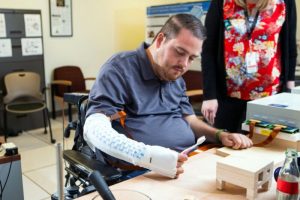Battelle Funds OSU Research to Give ‘Feeling’ to Paralyzed Hands
When Ian Burkhart severed his spinal cord after a diving accident in 2010, paralysis in his hands and legs made it impossible to hold anything or walk. In 2014, the nonprofit Battelle and Ohio State University Wexner Medical Center tried to restore his hand motion with a brain-computer interface (BCI) implanted in his skull. It gave him the ability to play Guitar Hero and push buttons on the game’s lightweight toy guitar, but he still lacked feeling in his hands.

Ian Burkhart demonstrates his dexterity through a haptic sleeve and brain implant connection. (Source Battelle)
According to a story in thenextweb.com, the group recently took the BCI to the next level, splitting signals into those used for motion, which were sent to his forearm, and those used for touch, which went to an armband on his bicep.
“The signals were then converted into vibrations, which tell Burkhart when he’s touching an object and how hard he’s gripping it. The effect is comparable to the vibration feedback used in videogame controllers,” thenextweb.com story says.
Now Burkhart can not only feel objects, but he can also control his hands much more effectively because of the NeuroLife system.
“It has been amazing to see the possibilities of sensory information coming from a device that was originally created to only allow me to control my hand in a one-way direction,” said Burkhart.
The use of video game technology is the first step in what may become an option for paraplegics to gain the use of limbs. The research paper is being published in the prestigious scientific journal Cell, according to a Battelle press release.
“Medical technologies like these that provide both movement and sensation back to their users has the potential to improve independence. “Helping people to become more whole again and less dependent on caregivers is a major step in improving quality of life,” said Justin Sanchez who is a Battelle Life Sciences Technical Fellow.
According to a story on arstechnica.com, Battelle has made advances in the brain implant area that other companies have yet to reach, like Neuralink’s BCI. Adding “feeling” to the connection is a major breakthrough.
“The haptic feedback gives Burkhart more control over his hand movements, as well as the ability to sense the correct amount of pressure to use while picking up different objects, like a styrofoam cup, which requires a lighter grip than a heavier ceramic coffee mug,” says the arstechnica.com story. “This is also the first BCI that can manage restoration of movement and the sense of touch at the same time.”
Battelle’s NeuroLife team is working on developing a home-based BCI system controlled by a tablet instead of a desktop computer for people with tetraplegia (also known as quadriplegia).
read more at wired.com







Leave A Comment